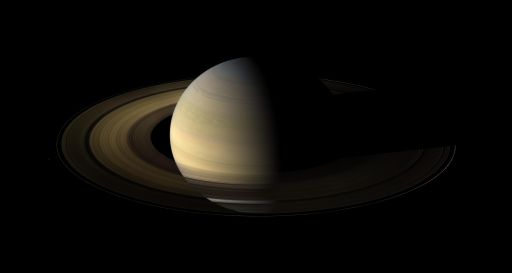Emily Lakdawalla • Sep 21, 2009
Saturn equinox image goodies
Well I'd hoped to get a full story on these amazing images posted before I had to dive into afternoon kid-related duties, but I just ran out of time. So here's a preview. Much more to come later!

NASA / JPL / Space Science Institute
Saturn at equinox
Just a day after the equinox, Cassini turned to capture the 75 images necessary to compose this striking panorama across Saturn and its rings. It's a rare and bizarre view of Saturn with the Sun poised almost exactly over the equator. With this lighting geometry, the rings are nearly dark, except where reflected light from Saturn strikes them, or where structures that rise above the plane of the rings catch the sunlight. The rings' shadow has collapsed to a skinny line falling across Saturn's waist.Because of difficult geometric and lighting conditions, extensive processing was required to create this view. Cassini was relatively close to Saturn when it began taking the images for the mosaic and was continuously receding from the planet during the eight hours it took to capture the 200 images contained in the observation. (Photos were captured through infrared, violet, and clear filters in addition to the red, green, and blue-filter images used for the mosaic shown here.) So each of the images had to be reprojected into a common viewing geometry. The photos also had to be digitally processed to remove lens flares (artifacts that result from light scattering within the camera's optics) and to deemphasize seams between images.
Additional processing was necessary to make the rings visible on your computer screen. Without enhancement, the rings would have been so dark as to be invisible. The dark half of the rings (right side of the mosaic) has been brightened relative to the bright half, (left side of the mosaic) by a factor of three, and then the entire ring system brightened by a factor of 20. Spokes are visible in the B ring on the right side of the image.
Similar brightening was required to make the moons visible. Janus (179 kilometers in diameter) is on the lower left of this image. Epimetheus (113 kilometers) appears near the middle bottom. Pandora (81 kilometers) orbits outside the rings on the right of the image. The small moon Atlas (30 kilometers) orbits inside the thin F ring on the right of the image. Other bright specks are background stars.
Cassini had passed through its orbital periapsis at 11:37 UTC on August 11 and almost immediately crossed to the northern face of the rings, at 12:59. This crossing was only 10 hours after the Sun had precisely balanced over the plane (at 02:44). Cassini began capturing the images for this mosaic at about 06:00 on August 12, about 1.25 days after the moment of equinox, and finished taking data at about 14:00.
Support our core enterprises
Your support powers our mission to explore worlds, find life, and defend Earth. You make all the difference when you make a gift. Give today!
Donate

 Explore Worlds
Explore Worlds Find Life
Find Life Defend Earth
Defend Earth

